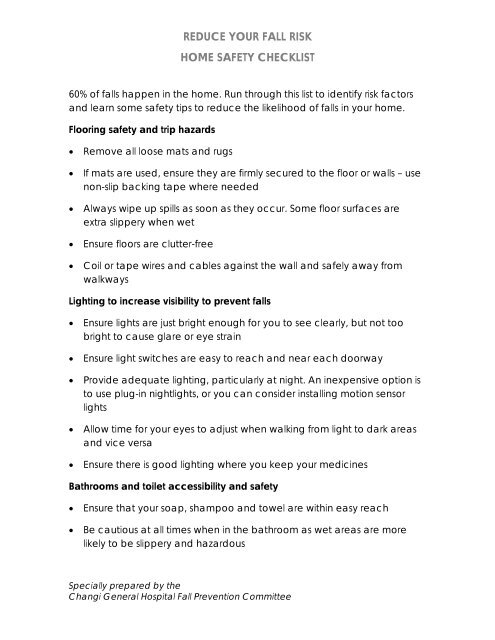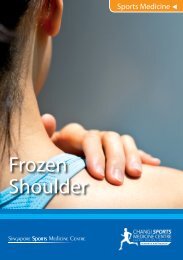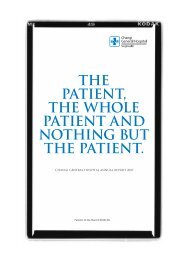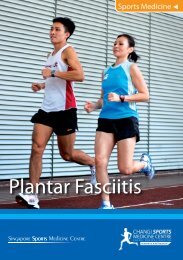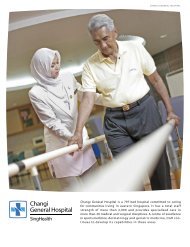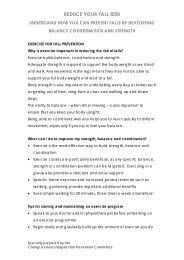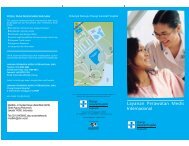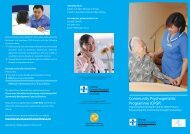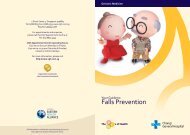Home Safety Checklist - Changi General Hospital
Home Safety Checklist - Changi General Hospital
Home Safety Checklist - Changi General Hospital
Create successful ePaper yourself
Turn your PDF publications into a flip-book with our unique Google optimized e-Paper software.
REDUCE YOUR FALL RISK<br />
HOME SAFETY CHECKLIST<br />
60% of falls happen in the home. Run through this list to identify risk factors<br />
and learn some safety tips to reduce the likelihood of falls in your home.<br />
Flooring safety and trip hazards<br />
• Remove all loose mats and rugs<br />
• If mats are used, ensure they are firmly secured to the floor or walls – use<br />
non-slip backing tape where needed<br />
• Always wipe up spills as soon as they occur. Some floor surfaces are<br />
extra slippery when wet<br />
• Ensure floors are clutter-free<br />
• Coil or tape wires and cables against the wall and safely away from<br />
walkways<br />
Lighting to increase visibility to prevent falls<br />
• Ensure lights are just bright enough for you to see clearly, but not too<br />
bright to cause glare or eye strain<br />
• Ensure light switches are easy to reach and near each doorway<br />
• Provide adequate lighting, particularly at night. An inexpensive option is<br />
to use plug-in nightlights, or you can consider installing motion sensor<br />
lights<br />
• Allow time for your eyes to adjust when walking from light to dark areas<br />
and vice versa<br />
• Ensure there is good lighting where you keep your medicines<br />
Bathrooms and toilet accessibility and safety<br />
• Ensure that your soap, shampoo and towel are within easy reach<br />
• Be cautious at all times when in the bathroom as wet areas are more<br />
likely to be slippery and hazardous<br />
Specially prepared by the<br />
<strong>Changi</strong> <strong>General</strong> <strong>Hospital</strong> Fall Prevention Committee
REDUCE YOUR FALL RISK<br />
HOME SAFETY CHECKLIST<br />
• Use non-slip mats in the bathroom or install slip-resistant flooring<br />
• Sit on a stable shower chair with back support to make shower time safer<br />
• Install grab bars and/or use a raised toilet seat if you have difficulty<br />
getting on and off the toilet<br />
Kitchen safety and accident prevention<br />
• Organise your kitchen so that frequently used items are easy to find and<br />
access without the need to climb, bend or reach<br />
• Ensure there is good lighting over table tops and other work areas<br />
• Clean up spills as soon as they occur<br />
• Ensure your kitchen is clutter-free<br />
• Use a broad based, sturdy and secure ladder if it is absolutely necessary<br />
to reach high places. Never use plastic stools or chairs<br />
Living room organisation for accessibility and safety<br />
• Opt for solid chairs of correct height with solid armrests as these are<br />
easier to get up from. Ensure that you can place your feet flat on the<br />
ground when seated<br />
• Avoid sitting on soft low sofas that make sitting and getting up difficult<br />
• Place standing fans at the corners and not in the middle of a room or<br />
walkway<br />
• Organise furniture so that you do not have to stretch or lean too far to<br />
open windows<br />
• Place your telephone within easy reach; cordless telephones are ideal<br />
• Ensure your doorbell is in working condition<br />
Bedroom safety, lighting and accessibility<br />
Specially prepared by the<br />
<strong>Changi</strong> <strong>General</strong> <strong>Hospital</strong> Fall Prevention Committee
REDUCE YOUR FALL RISK<br />
HOME SAFETY CHECKLIST<br />
• Check that you can easily switch on a light from your bed when you get<br />
up at night, otherwise, set up extra lights or lamps next to your bed<br />
• Consider a touch lamp or a night lamp within reach of your bed at night<br />
• Keep a telephone beside your bed<br />
• Keep bedroom floors free of clutter<br />
• Secure loose telephone and electrical cords against the wall do not<br />
cause tripping<br />
• Ensure your eyeglasses are easy to reach if you need them when you<br />
get out of bed<br />
• Check that beds are easy to get into and out of; use a firm mattress and<br />
ensure that the bed is of an appropriate height. You should be able to<br />
place your feet flat on the floor when sitting at the edge of the bed.<br />
Your knees should be at a comfortable 90 o angle<br />
• If you are having difficulty into or out of your bed, seek advice from an<br />
occupational therapist<br />
• Ensure your bedspread is clear off the floor and is not a trip hazard<br />
• Get out of bed slowly – sit for a short time before you stand up<br />
• Have your walking aid handy in case you get up in the night<br />
Clothing and footwear advice<br />
• Wear shoes that have non-slip soles and rounded low, broad heels<br />
• Avoid wearing only socks, slippers, shoes with slippery soles and high<br />
heels<br />
• Check that clothing (pants, dresses and long skirts) end above the ankle<br />
to avoid tripping<br />
• Sit down rather than stand when dressing<br />
Specially prepared by the<br />
<strong>Changi</strong> <strong>General</strong> <strong>Hospital</strong> Fall Prevention Committee


